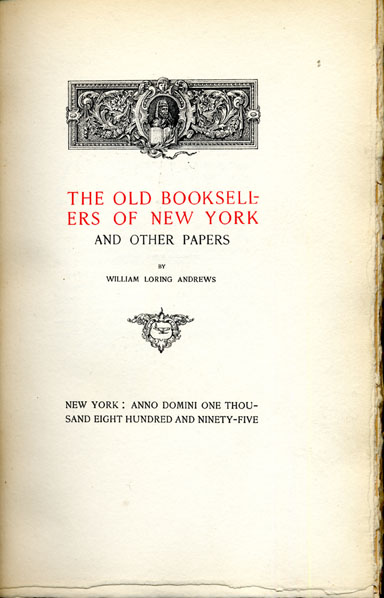The Old Booksellers of New York and other papers<br>By William Loring Andrews
- by William Loring Andrews

none
By William Loring Andrews
New York: Anno Domini One Thousand Eight Hundred and Ninety-Five
THIS brief account of the old booksellers of New York includes—with very few exceptions—only those members of the Fraternity who came within the cognizance of the writer, and who now have passed off the stage. Short as is the story, it covers a period during which the old book trade had its rise and became a permanently established business in this city.
These papers were prepared for and have appeared in part, in the pages of “The Bookman.'' They are now presented in book form, with embellishments consisting of head and tail pieces, initial letters and three full-page copper plate engravings by Mr. E. Davis French.
List of Plates
- An East View of Trinity Church, New York, Copied from the Original, in the New York Magazine, 1790. Engraved by E. D. French.
- Nassau Street, New York, in 1895. Engraved by E. D. French.
- Government House, New York, Copied from the Original, In New York Magazine, 1795. Engraved by E. D. French
- Title Page of Nathaniel Ames' Almanac for 1760. Facsimile Reproduction.
"There's nothing hath enduring youth Eternal newness, strength unfailing. Except old books, old friends, old truth That's ever battling-still prevailing."
WILLIAM GOWANS
In the opening chapter of the Notes to Peabody's "Views in New York and Its Environs," published in 1831, Theodore B. Fay, co-editor of the New York Mirror thus describes the city of his indwelling, and depicts in these grandiloquent terms the enviable estate of his fellow townsmen and the proud future which unveiled its glittering vista before them:
"A vast city, with its bristling forest of masts and spires, sending forth the hum of more than 200,000 inhabitants. Freedom, peace and plenty are in their dwellings, and their destiny is as unclouded as the glorious vault of Heaven, which stretches with all its stars above their heads."
The Gothamite of the first half of the 19th century possessed implicit faith as well as unbounded pride in his fair and thriving city. A dabbler in statistics of this period, who applied to his computations the plain and simple "rule of three, "developed the astounding fact that by the year 1900 New York city should contain a population of over 5,000,000 souls. To be precise, 5,257,193. He admits that wars, pestilences and political convulsions, such as from time to time befall all communities, might possibly interfere with this steady arithmetical progression ; nevertheless, he is confident that by the expiration of the time specified the population of New York will exceed that of any other city on the face of the earth, Pekin alone excepted. London would be left far in the background. Four years after the date of this prediction (December 16th, 1835), the "Great Fire" swept with its besom of destruction over the larger portion of the business section of the city of New York, and left it a mass of smoking ruins. Six hundred and seventy-four houses, many of them occupied by the largest shipping and wholesale dry-goods merchants, were, with most of their contents, burned to the ground. Our prophet had not reckoned with the demon of fire; still, this widespread disaster stayed only momentarily the onward march of the metropolis. Phoenix-like, it rose from its ashes, and, while it has not attained the full measure of greatness ciphered out for it with such facility by the optimist whom we have quoted, still we venture to claim that the chief city of the Western world has fairly fulfilled the rosy promise of its youth.